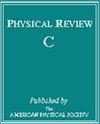横向动量守恒和流动的对称累积量 sc2,4{4} 和非对称累积量 ac2{3}
IF 3.4
2区 物理与天体物理
Q1 Physics and Astronomy
引用次数: 0
摘要
多粒子累积量方法可用于揭示小型和大型碰撞系统中的长程集合性。计算了横向动量守恒和流动产生的四粒子对称累积量sc2,4{4}、三粒子不对称累积量ac2{3}以及归一化累积量nsc2,4{4}和nac2{3}。我们还研究了这两种效应之间的相互作用。我们的结果与最近 ATLAS 用子事件累积法测量多粒子方位相关性的结果非常吻合,这为洞察小系统中集体流动的起源提供了依据。本文章由计算机程序翻译,如有差异,请以英文原文为准。

Symmetric cumulant sc2,4{4} and asymmetric cumulant ac2{3} from transverse momentum conservation and flow
Multiparticle cumulants method can be used to reveal long-range collectivity in small and large colliding systems. The four-particle symmetric cumulant , three-particle asymmetric cumulant , and the normalized cumulants and from the transverse momentum conservation and flow are calculated. The interplay between the two effects is also investigated. Our results are in a good agreement with the recent ATLAS measurements of multiparticle azimuthal correlations with the subevent cumulant method, which provides insight into the origin of collective flow in small systems.
求助全文
通过发布文献求助,成功后即可免费获取论文全文。
去求助
来源期刊

Physical Review C
物理-物理:核物理
CiteScore
5.70
自引率
35.50%
发文量
0
审稿时长
1-2 weeks
期刊介绍:
Physical Review C (PRC) is a leading journal in theoretical and experimental nuclear physics, publishing more than two-thirds of the research literature in the field.
PRC covers experimental and theoretical results in all aspects of nuclear physics, including:
Nucleon-nucleon interaction, few-body systems
Nuclear structure
Nuclear reactions
Relativistic nuclear collisions
Hadronic physics and QCD
Electroweak interaction, symmetries
Nuclear astrophysics
 求助内容:
求助内容: 应助结果提醒方式:
应助结果提醒方式:


